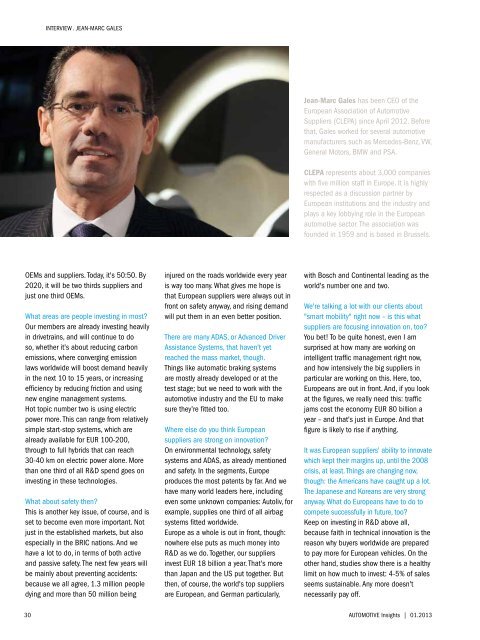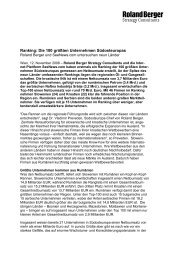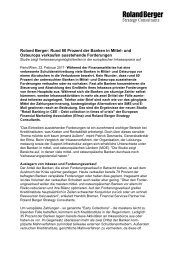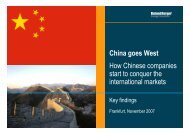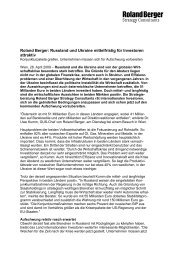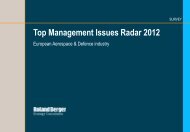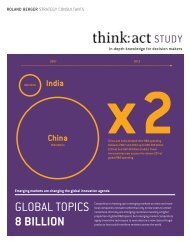Automotive Insights 01.2013 - Roland Berger
Automotive Insights 01.2013 - Roland Berger
Automotive Insights 01.2013 - Roland Berger
You also want an ePaper? Increase the reach of your titles
YUMPU automatically turns print PDFs into web optimized ePapers that Google loves.
INterview . Jean-Marc Gales<br />
Jean-Marc Gales has been CEO of the<br />
European Association of <strong>Automotive</strong><br />
Suppliers (CLEPA) since April 2012. Before<br />
that, Gales worked for several automotive<br />
manufacturers such as Mercedes-Benz, VW,<br />
General Motors, BMW and PSA.<br />
CLEPA represents about 3,000 companies<br />
with five million staff in Europe. It is highly<br />
respected as a discussion partner by<br />
European institutions and the industry and<br />
plays a key lobbying role in the European<br />
automotive sector. The association was<br />
founded in 1959 and is based in Brussels.<br />
OEMs and suppliers. Today, it's 50:50. By<br />
2020, it will be two thirds suppliers and<br />
just one third OEMs.<br />
What areas are people investing in most<br />
Our members are already investing heavily<br />
in drivetrains, and will continue to do<br />
so, whether it's about reducing carbon<br />
emissions, where converging emission<br />
laws worldwide will boost demand heavily<br />
in the next 10 to 15 years, or increasing<br />
efficiency by reducing friction and using<br />
new engine management systems.<br />
Hot topic number two is using electric<br />
power more. This can range from relatively<br />
simple start-stop systems, which are<br />
already available for EUR 100-200,<br />
through to full hybrids that can reach<br />
30-40 km on electric power alone. More<br />
than one third of all R&D spend goes on<br />
investing in these technologies.<br />
What about safety then<br />
This is another key issue, of course, and is<br />
set to become even more important. Not<br />
just in the established markets, but also<br />
especially in the BRIC nations. And we<br />
have a lot to do, in terms of both active<br />
and passive safety. The next few years will<br />
be mainly about preventing accidents:<br />
because we all agree, 1.3 million people<br />
dying and more than 50 million being<br />
injured on the roads worldwide every year<br />
is way too many. What gives me hope is<br />
that European suppliers were always out in<br />
front on safety anyway, and rising demand<br />
will put them in an even better position.<br />
There are many ADAS, or Advanced Driver<br />
Assistance Systems, that haven't yet<br />
reached the mass market, though.<br />
Things like automatic braking systems<br />
are mostly already developed or at the<br />
test stage; but we need to work with the<br />
automotive industry and the EU to make<br />
sure they're fitted too.<br />
Where else do you think European<br />
suppliers are strong on innovation<br />
On environmental technology, safety<br />
systems and ADAS, as already mentioned<br />
and safety. In the segments, Europe<br />
produces the most patents by far. And we<br />
have many world leaders here, including<br />
even some unknown companies: Autoliv, for<br />
example, supplies one third of all airbag<br />
systems fitted worldwide.<br />
Europe as a whole is out in front, though:<br />
nowhere else puts as much money into<br />
R&D as we do. Together, our suppliers<br />
invest EUR 18 billion a year. That's more<br />
than Japan and the US put together. But<br />
then, of course, the world's top suppliers<br />
are European, and German particularly,<br />
with Bosch and Continental leading as the<br />
world's number one and two.<br />
We're talking a lot with our clients about<br />
"smart mobility" right now – is this what<br />
suppliers are focusing innovation on, too<br />
You bet! To be quite honest, even I am<br />
surprised at how many are working on<br />
intelligent traffic management right now,<br />
and how intensively the big suppliers in<br />
particular are working on this. Here, too,<br />
Europeans are out in front. And, if you look<br />
at the figures, we really need this: traffic<br />
jams cost the economy EUR 80 billion a<br />
year – and that's just in Europe. And that<br />
figure is likely to rise if anything.<br />
It was European suppliers' ability to innovate<br />
which kept their margins up, until the 2008<br />
crisis, at least. Things are changing now,<br />
though: the Americans have caught up a lot.<br />
The Japanese and Koreans are very strong<br />
anyway. What do Europeans have to do to<br />
compete successfully in future, too<br />
Keep on investing in R&D above all,<br />
because faith in technical innovation is the<br />
reason why buyers worldwide are prepared<br />
to pay more for European vehicles. On the<br />
other hand, studies show there is a healthy<br />
limit on how much to invest: 4-5% of sales<br />
seems sustainable. Any more doesn't<br />
necessarily pay off.<br />
30<br />
<strong>Automotive</strong> <strong>Insights</strong> | <strong>01.2013</strong>


